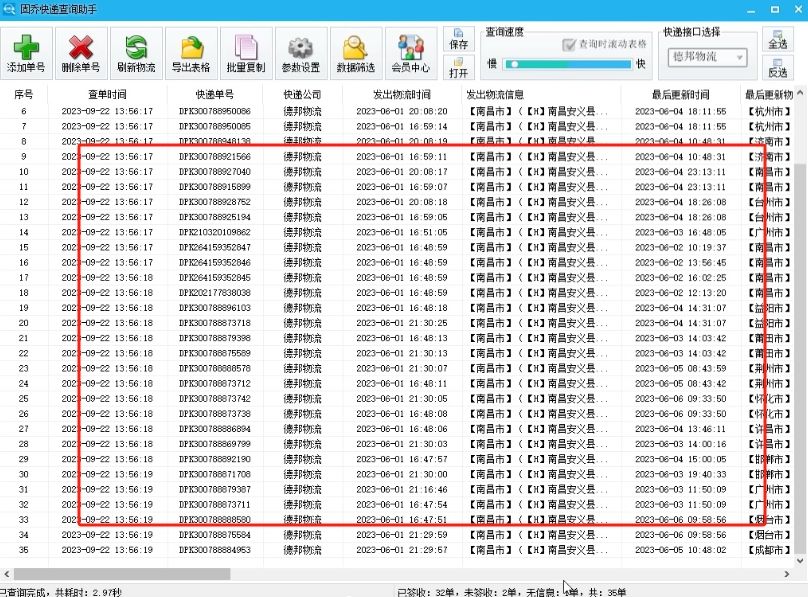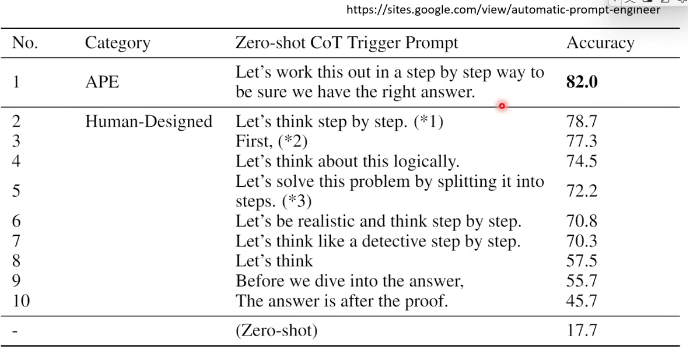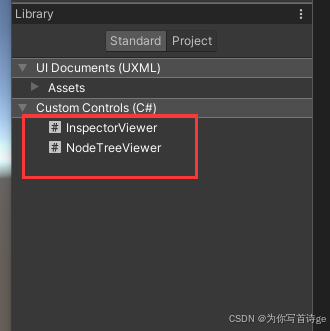文章目录
- PyQt界面开发的两种方式:可视化UI + 编程式UI
- 一、PyQt 简介
- 二、PyQt 与 Qt 的蒙娜丽莎
- 三、PyQt 布局管理器(Layout Manager)
- 3.1、简介
- 3.1.1、布局管理器的定义
- 3.1.2、布局管理器的类型
- 3.1.3、布局管理器的使用方法
- 3.2、项目实战
- 3.2.0、添加伸缩项 layout.addStretch:控制部件之间的间距
- 3.2.1、垂直布局管理器 QVBoxLayout:按照从上到下的顺序排列部件
- 3.2.2、水平布局管理器 QHBoxLayout:按照从左到右的顺序排列部件
- 3.2.3、网格布局管理器 QGridLayout:指定每个部件的位置(行 + 列)
- 3.2.4、表单布局管理器 QFormLayout:对齐标签和输入框
- 3.2.5、堆叠布局管理器 QStackedLayout:在一个窗口中,管理多个窗口,但同一时刻只能显示一个窗口(如:选项卡界面)
- 四、PyQt 常用组件
- 4.1、简介
- 4.2、项目实战
- 【菜单类 - 组件】菜单+菜单栏+工具栏+状态栏 QMenuBar + QMenu + QToolBar + QStatusBar
- 【对话框类 - 组件】输入对话框+颜色对话框+字体对话框+文件选择对话框+进度对话框+消息对话框:QInputDialog + QColorDialog + QFontDialog + QFileDialog + QProgressDialog + QMessageBox
- 4.2.0、设置组件属性:尺寸 + 颜色 + 连接到槽(状态变化)
- 4.2.1、显示文本 QLabel:Hello, PyQt!
- 4.2.2、按钮 QPushButton:用户登录界面
- 4.2.3、文本框 QLineEdit + QTextEdit(单行 + 多行) —— 文本改变
- 4.2.4、校验器 QRegExpValidator :用于限制用户在 QLineEdit 中输入的文本(英文 / 数字)
- 4.2.5、校验器 QIntValidator + QDoubleValidator(整数 + 浮点数):用于限制用户在 QLineEdit 中输入的文本必须为数字。
- 4.2.6、输入框 QSpinBox + QDoubleSpinBox(整数 + 浮点数):支持上下按钮调节
- 4.2.7、滑动条 QSlider:获取滑动条点击前后的值
- 4.2.8、进度条 QProgressBar:创建一个进度条窗口(0~100%)
- 4.2.9、下拉框 QComboBox:创建一个下拉框并添加选项
- 4.2.10、复选框 QCheckBox:获取勾选状态
- 4.2.11、单选按钮 QRadioButton:获取勾选状态
- 4.2.12、分组框 QGroupBox:将其他小部件放置在其中
- 4.2.12、打印日志 QTextEdit:获取当前时间 + 设置文本颜色
- 4.2.13、消息提示框 QMessageBox:信息 / 询问 / 警告 / 错误
- 4.2.14、选项卡界面 QTabWidget
- 4.2.14.1、在一个窗口中显示多个页面
- 4.2.14.2、在主界面中,显示其他.py界面类文件
- 4.2.14.3、在主界面中,显示其他.py界面类文件,并进行数据交互
- 4.2.15、调用其他.py文件,并数据交互
- 测试文件.py
- 方法一:subprocess(subprocess.run)
- 方法二:QProcess(process.start)
- 4.2.16、在当前虚拟环境下,调用其他虚拟环境下的.py文件,并数据交互
PyQt界面开发的两种方式:可视化UI + 编程式UI
- 编程式UI:
详细介绍了每个组件的属性,可以当作百科书学习一波- 可视化UI :
PyQt5 保姆级教程(从入门到精通)
PyQt5 小白从零开始(汇总篇)
PyQt5 快速上手(基础知识)
PyQt5 快速入门(bilibili视频教程)
(1)
可视化UI:基于Qt Designer可视化编辑工具进行组件拖放、属性设置、布局管理等操作创建界面。
- 一是将其保存为.ui文件,然后在PyQt应用程序中加载和使用.ui文件。
- 二是使用pyuic工具将 .ui转为 .py,然后直接对Python代码进行使用。
(2)
编程式UI或手写UI:直接使用Python代码来创建和配置用户界面组件,而无需依赖可视化编辑工具。
编程式UI优点:
灵活性:完全掌握界面的创建和交互过程,可以根据需要随时动态创建、修改或删除组件,以满足特定需求。定制化:可以精确地控制每个组件的属性、样式和行为,而不受可视化编辑器的限制。因此可以创建高度定制的界面,以满足特定的设计需求。动态性:在运行时动态地创建、修改和删除组件,以响应用户交互或应用程序状态的变化。对于需要动态更新界面的应用程序非常有用。版本控制:可以将整个应用程序界面的定义保存在代码文件中,这使得版本控制更容易,能够跟踪和管理界面的变化。跨平台:Python代码来创建界面,可以实现跨平台的GUI应用程序,因为PyQt是跨平台的,可以在不同操作系统上运行。
编程式UI缺点:
可读性差: 对于不熟悉代码的人来说,代码中的界面布局和配置可能不太容易理解,而可视化编辑器可以提供更直观的可视反馈。难以预览:需要运行程序才能看到界面,而可视化编辑器可以实时看到界面。时间消耗:需要编写更多的代码。如:布局、样式以及更复杂的界面。
如果你有一个main.py文件,但想要在Qt Designer中编辑界面。
(1)使用Qt Designer:创建一个.ui文件,然后将main.py文件中与界面相关的代码复制到.ui中。
(2)使用Qt Designer:编辑和保存.ui。
(3)使用pyuic工具:将.ui转为.py文件,然后将main.py文件中与算法逻辑相关的代码复制到.py中。
注意:仅限于保存静态的界面设计,而不包括任何与界面相关的算法逻辑。
- Qt Designer工具通常用于创建和编辑.ui文件
- .ui文件:包含界面设计的代码。
- .py文件:包含界面设计 + 算法逻辑的代码。
一、PyQt 简介
PyQt官网首页:https://www.riverbankcomputing.com/software/pyqt/
通过 pip 安装 PyQt:pip install pyqt5
PyQt定义
(1)是Python编程语言的一个GUI(图形用户界面)工具包,它允许开发人员使用Python语言创建桌面应用程序。PyQt提供了许多用于创建丰富多样的用户界面的类和功能,以及用于处理用户输入和交互的工具。
(2)是基于Qt库的Python封装,Qt是一个流行的C++框架,用于开发跨平台的应用程序。
PyQt版本
提供了与Qt应用程序框架的Python绑定。每个版本的PyQt都是为不同的Qt版本而设计的。 目前PyQt只支持两个版本:
- PyQt6:仅支持Python 3.6及更高版本,仅支持 Qt6 版本。(1)模块名称变更:在PyQt6中,模块名称进行了更改,以更好地与标准Qt模块名称匹配。例如,QtWidgets模块在PyQt6中被称为QtWidgets,而不是PyQt5.QtWidgets。(2)新特性:PyQt6引入了一些新特性,改进了现有功能,以适应Qt6的变化。这包括新的信号和槽语法等。(3)与PyQt5不同,PyQt6不再支持Qt4。
- PyQt5:仅支持Python 2.7和Python 3.x,仅支持 Qt5 版本。但Python 2在2020年已不再得到官方支持。(
广泛使用)PyQt5是最广泛使用的版本,许多应用程序和项目都在使用它。- PyQt4:主要支持Python 2.x,仅支持 Qt4 版本。尽管它也有一个用于Python 3的版本,但相对较少使用。(
已经过时)不再得到官方支持,因此不建议在新项目中使用它。
二、PyQt 与 Qt 的蒙娜丽莎
Qt 和 PyQt 是用于创建图形用户界面(GUI)的工具包,它们提供了丰富的类和功能,可以用于开发跨平台的桌面应用程序。
Qt(跨平台的C++应用程序开发框架):
(1)Qt是由挪威公司Trolltech(现在是Qt公司的一部分)开发。它最初是为了解决C++开发人员在不同平台上编写重复代码的问题而设计的。
(2)支持多种操作系统(跨平台):Windows、macOS、Linux、iOS、Android等,因此可以实现跨平台的开发和部署。
(3) 用户交互和事件:Qt是一个面向对象的框架,使用信号和槽机制来处理用户交互和事件。
PyQt(Qt的Python绑定,使用Python语言调用和使用Qt框架的功能):
(1)PyQt由Riverbank Computing公司开发和维护。
(2)支持多种操作系统(跨平台):因为PyQt是基于Qt的,并且可以在各种操作系统上运行。
(3)用户交互和事件:PyQt使用Qt的信号和槽机制来处理用户交互和事件,同时也支持Python的语法和特性。备注:PyQt同时支持Qt Designer(图形界面设计器),开发者可以通过Qt Designer可视化设计界面,然后将其转换为Python代码。
Qt 和 PyQt 的区别:
- 编程语言:Qt是C++编写,而PyQt是Qt的Python编写。
- 开发体验:PyQt相对于Qt更容易上手,Python代码通常比C++代码更简洁和易读。
- 性能差异:由于Qt是用C++编写的,其性能可能比PyQt稍微好一些。然而,对于大多数应用程序而言,性能差异并不明显,而开发效率更重要。
- 应用领域:由于Qt和PyQt都是用于GUI开发的,因此它们在各种应用领域中都有广泛的应用,包括桌面应用程序、嵌入式系统、游戏开发、数据可视化等。
- 生态系统:Qt拥有广泛的C++社区和生态系统,可以找到更多的第三方库和资源。相比之下,PyQt稍逊一筹。
三、PyQt 布局管理器(Layout Manager)
3.1、简介
3.1.1、布局管理器的定义
布局管理器(Layout Manager):用于在图形用户界面(GUI)中管理窗口中部件(Widget)布局的工具。通过容器的方式来布置和管理部件的位置和大小,而无需手动计算和设置每个部件的位置(但支持)。
自动布局:根据容器的大小和约束,自动排列和调整部件的位置和大小。这样,当窗口大小改变时,部件的布局也会自动调整,无需手动修改。支持多种类型:水平布局、垂直布局、网格布局等。支持容器嵌套:可以将多个布局管理器嵌套在一起,从而实现复杂的布局设计。- 可扩展性:布局管理器通常具有一定的可扩展性,允许开发者编写自定义的布局管理器,以满足特定的布局需求。
- 与部件关联:布局管理器通常与部件相关联,开发者可以将部件添加到布局管理器中,并指定部件在布局中的位置和大小。
- 事件处理:一些布局管理器还可以处理部件的事件,例如调整大小事件、重绘事件等,以便实现更高级的交互功能。
- 跨平台性兼容性:布局管理器通常是跨平台的,可以在不同的操作系统上使用,并且能够保持一致的布局效果。
3.1.2、布局管理器的类型
盒子布局管理器 QBoxLayout:无法单独使用,其是QVBoxLayout和QHBoxLayout的基类,具体用法参考垂直和水平布局管理器。垂直布局管理器 QVBoxLayout:将部件 从上到下(垂直的) 排列在一列中。水平布局管理器 QHBoxLayout:将部件 从左到右(水平的) 排列在一行中。网格布局管理器 QGridLayout:将部件 指定位置(行 + 列) 排列在一个网格中。
- 如:在同一行中,指定多个部件的位置布局:[3 3 3] to [33 3] 表示将111格式变换为112格局。
表单布局管理器 QFormLayout:对齐标签和输入框。常用于创建表单式的用户界面。堆叠布局管理器 QStackedLayout:管理多个窗口部件,但同一时刻只能显示一个布局管理器,可以通过界面切换以显示不同的部件。如:选项卡界面。
3.1.3、布局管理器的使用方法
(1)将部件添加到布局管理器中
(2)将布局管理器设置为窗口或部件(Widget)的主要布局(即可实现自动布局)
"""###################################
(1)管理子部件
(2)将子部件给到主部件
(3)窗口显示主部件
###################################"""layout = QVBoxLayout() # 创建一个垂直布局管理器对象(用于管理垂直排列的子部件)
layout.addWidget(container_widget) # 将名为container_widget的部件添加到垂直布局中central_widget = QWidget() # 创建一个QWidget对象(用作主窗口的中央部件)
central_widget.setLayout(layout) # 将布局设置为central_widget的布局管理器,使布局成为central_widget的主要布局
self.setCentralWidget(central_widget) # 将central_widget设置为主窗口(通常是QMainWindow)的中央部件,以便显示在窗口中
3.2、项目实战
3.2.0、添加伸缩项 layout.addStretch:控制部件之间的间距
import sys
from PyQt5.QtWidgets import QApplication, QMainWindow, QVBoxLayout, QHBoxLayout, QPushButton, QLabel, QWidget, QSliderclass MainWindow(QMainWindow):def __init__(self):super().__init__()VBox_layout = QVBoxLayout()HBox_Layout = QHBoxLayout()slider = QSlider()slider.setFixedHeight(500)label1 = QLabel("Label 1")label2 = QLabel("Label 2")label3 = QLabel("Label 3")# (1)若在部件之前添加伸缩项,部件跟在伸缩项的后面,从而实现将部件布局到底部VBox_layout.addStretch(8)HBox_Layout.addWidget(slider)VBox_layout.addWidget(label1)VBox_layout.addWidget(label2)VBox_layout.addWidget(label3)HBox_Layout.addLayout(VBox_layout)VBox_layout.addStretch(1)# (2)若在部件之后添加伸缩项,部件被伸缩项顶在前面,从而实现将部件布局到顶部# (3)若在部件之前及之后分别添加伸缩项:将部件布局到中间central_widget = QWidget()central_widget.setLayout(HBox_Layout)self.setCentralWidget(central_widget)if __name__ == "__main__":app = QApplication(sys.argv)window = MainWindow()window.show()sys.exit(app.exec_())"""##########################################################################
函数简介:在布局中创建一个弹性空间,用于调整布局中各个部件的间距,以实现更好的分布和对齐效果。
函数说明:layout.addStretch()
输入参数:伸缩项的权重为0(默认),这意味着它不会占用任何额外的空间。伸缩项的权重为1(常用),将会根据权重在布局中占据一部分空间,从而将其他部件推向布局的边缘。备注:若为其余数字,则权重值越大,伸缩空间越大。
##########################################################################"""3.2.1、垂直布局管理器 QVBoxLayout:按照从上到下的顺序排列部件

import sys
from PyQt5.QtWidgets import QApplication, QMainWindow, QVBoxLayout, QWidget, QPushButtonclass MainWindow(QMainWindow):def __init__(self):super().__init__()vbox = QVBoxLayout()button1 = QPushButton("Button 1")button2 = QPushButton("Button 2")button3 = QPushButton("Button 3")vbox.addWidget(button1)vbox.addWidget(button2)vbox.addWidget(button3)central_widget = QWidget()central_widget.setLayout(vbox)self.setCentralWidget(central_widget)if __name__ == "__main__":app = QApplication(sys.argv)window = MainWindow()window.show()sys.exit(app.exec_())3.2.2、水平布局管理器 QHBoxLayout:按照从左到右的顺序排列部件

import sys
from PyQt5.QtWidgets import QApplication, QMainWindow, QWidget, QHBoxLayout, QPushButtonclass MainWindow(QMainWindow):def __init__(self):super().__init__()hbox = QHBoxLayout()button1 = QPushButton("Button 1")button2 = QPushButton("Button 2")button3 = QPushButton("Button 3")hbox.addWidget(button1)hbox.addWidget(button2)hbox.addWidget(button3)central_widget = QWidget()central_widget.setLayout(hbox)self.setCentralWidget(central_widget)if __name__ == "__main__":app = QApplication(sys.argv)window = MainWindow()window.show()sys.exit(app.exec_())3.2.3、网格布局管理器 QGridLayout:指定每个部件的位置(行 + 列)

import sys
from PyQt5.QtWidgets import QApplication, QMainWindow, QWidget, QGridLayout, QPushButtonclass MainWindow(QMainWindow):def __init__(self):super().__init__()grid_layout = QGridLayout()button1 = QPushButton("Button 1")button2 = QPushButton("Button 2")button3 = QPushButton("Button 3")button4 = QPushButton("Button 4")button5 = QPushButton("Button 5")grid_layout.addWidget(button1, 0, 0) # 第一行第一列grid_layout.addWidget(button2, 0, 1) # 第一行第二列grid_layout.addWidget(button3, 1, 0) # 第二行第一列grid_layout.addWidget(button4, 1, 1) # 第二行第二列grid_layout.addWidget(button5, 1, 2, 1, 2) # 第二行的第三和第四列central_widget = QWidget()central_widget.setLayout(grid_layout)self.setCentralWidget(central_widget)if __name__ == "__main__":app = QApplication(sys.argv)window = MainWindow()window.show()sys.exit(app.exec_())3.2.4、表单布局管理器 QFormLayout:对齐标签和输入框

import sys
from PyQt5.QtWidgets import QApplication, QMainWindow, QWidget, QFormLayout, QLineEdit, QLabelclass MainWindow(QMainWindow):def __init__(self):super().__init__()form_layout = QFormLayout()label1 = QLabel("Name:")name_input = QLineEdit()label2 = QLabel("Email:")email_input = QLineEdit()label3 = QLabel("Phone:")phone_input = QLineEdit()form_layout.addRow(label1, name_input)form_layout.addRow(label2, email_input)form_layout.addRow(label3, phone_input)central_widget = QWidget()central_widget.setLayout(form_layout)self.setCentralWidget(central_widget)if __name__ == "__main__":app = QApplication(sys.argv)window = MainWindow()window.show()sys.exit(app.exec_())3.2.5、堆叠布局管理器 QStackedLayout:在一个窗口中,管理多个窗口,但同一时刻只能显示一个窗口(如:选项卡界面)


import sys
from PyQt5.QtWidgets import QApplication, QMainWindow, QWidget, QPushButton, QLabel, QVBoxLayout, QStackedLayoutclass MainWindow(QMainWindow):def __init__(self):super().__init__()self.setWindowTitle("Stacked Layout Example")self.stacked_layout = QStackedLayout()page1 = self.create_page("Page 1 Content", "Switch to Page 2")page2 = self.create_page("Page 2 Content", "Switch to Page 1")self.stacked_layout.addWidget(page1)self.stacked_layout.addWidget(page2)central_widget = QWidget()central_widget.setLayout(self.stacked_layout)self.setCentralWidget(central_widget)def create_page(self, content_text, switch_button_text):layout = QVBoxLayout()content_label = QLabel(content_text)switch_button = QPushButton(switch_button_text)switch_button.clicked.connect(self.switch_page)layout.addWidget(content_label)layout.addWidget(switch_button)page = QWidget()page.setLayout(layout)return pagedef switch_page(self):# 切换页面current_index = self.stacked_layout.currentIndex()next_index = (current_index + 1) % 2 # 切换到下一页(循环切换)self.stacked_layout.setCurrentIndex(next_index)if __name__ == "__main__":app = QApplication(sys.argv)window = MainWindow()window.show()sys.exit(app.exec_())四、PyQt 常用组件
在 GUI 编程中,术语"组件"、"部件"和"控件"通常用于指代用户界面的基本构建块。术语在不同的 GUI 框架和文档中会略有不同,但可以互换使用。
4.1、简介
PyQt提供了丰富的组件(也称为控件或部件),用于构建图形用户界面。
| 组件(Widget) | 简介 | |
|---|---|---|
| 窗口组件 | QWidget | 所有用户界面对象的基类,用于创建窗口和部件。 |
| QMainWindow | 主窗口的类,通常用作应用程序的主界面。 | |
| 基础组件 | QLabel | 显示文本或图像。 |
| QLineEdit | 输入单行文本。 | |
| QTextEdit | 输入多行文本。 | |
| QSpinBox | (数字)整数输入框。 | |
| QDoubleSpinBox | (数字)浮点数输入框。 | |
| QPushButton | 按钮。 | |
| QRadioButton | 单选按钮。在多个选项中进行单选。 | |
| QCheckBox | 复选框。在多个选项中进行多选 | |
| QGroupBox | 分组框。将其他小部件放置在其中 | |
| QSlider | 滑动条。 | |
| QTabWidget | 选项卡界面。 | |
| QComboBox | 下拉列表框。 | |
| 对话框类 - 组件 | QDialog | 自定义对话框 |
| QInputDialog | 获取用户输入对话框 | |
| QFontDialog | 字体对话框。 | |
| QColorDialog | 颜色对话框。 | |
| QProgressDialog | 进度对话框。 | |
| QFileDialog | 打开文件/文件夹对话框。 | |
| QMessageBox | 消息提示框。 | |
| 菜单类 - 组件 | QMenu | 菜单。 |
| QMenuBar | 菜单栏。 | |
| QToolBar | 工具栏。 | |
| QStatusBar | 状态栏。 | |
| QProgressBar | 进度条。 | |
| 绘图类 - 组件 | QGraphicsScene | 管理2D图形项的场景。 |
| QGraphicsView | 显示二维图形和图像。 | |
| QGraphicsItem | 在QGraphicsScene中显示图形项。 | |
| QTableView | 显示表格数据。 | |
| QTreeWidget | 显示树形数据。 | |
| QListWidget | 显示列表数据。 | |
| QCalendarWidget | 显示日历。 | |
| QDockWidget | 创建可停靠的面板。 | |
| QSplitter | 在界面中创建可调整大小的分割区域。 | |
| QScrollArea | 显示超过容器尺寸的内容,并支持滚动查看。 |
4.2、项目实战
【菜单类 - 组件】菜单+菜单栏+工具栏+状态栏 QMenuBar + QMenu + QToolBar + QStatusBar
QAction:用于表示用户界面上的动作或操作。常与菜单、工具栏和快捷键等用户界面组件连用,以便用户可以执行各种操作。
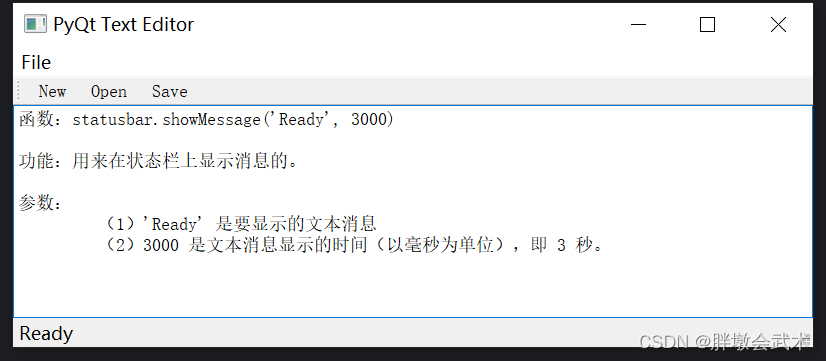
import sys
from PyQt5.QtWidgets import QApplication, QMainWindow, QMenu, QMenuBar, QToolBar, QStatusBar, QAction, QTextEdit, QFileDialogclass MyWindow(QMainWindow):def __init__(self):super().__init__()#################################################### 创建菜单栏menubar = self.menuBar()# 创建文件菜单file_menu = menubar.addMenu('File')# 创建文件菜单项new_action = QAction('New', self)open_action = QAction('Open', self)save_action = QAction('Save', self)exit_action = QAction('Exit', self)# 添加文件菜单项到文件菜单file_menu.addAction(new_action)file_menu.addAction(open_action)file_menu.addAction(save_action)file_menu.addSeparator() # 分隔线file_menu.addAction(exit_action)# 连接菜单项和工具按钮的槽函数new_action.triggered.connect(self.newFile)open_action.triggered.connect(self.openFile)save_action.triggered.connect(self.saveFile)exit_action.triggered.connect(self.exitApp)#################################################### 创建工具栏toolbar = self.addToolBar('Toolbar')# 在工具栏中添加工具按钮new_button = toolbar.addAction('New') # 清空(当前)文本编辑框open_button = toolbar.addAction('Open') # 打开txt文本并添加到文本编辑框save_button = toolbar.addAction('Save') # 保存文本编辑框到txt文本# 连接菜单项和工具按钮的槽函数new_button.triggered.connect(self.newFile)open_button.triggered.connect(self.openFile)save_button.triggered.connect(self.saveFile)#################################################### 创建状态栏statusbar = self.statusBar()# 在状态栏中显示消息: 'Ready' 是要显示的文本消息,30000 是消息显示的时间(以毫秒为单位),即30秒。statusbar.showMessage('Ready', 30000)#################################################### 创建文本编辑框self.text_edit = QTextEdit(self)self.setCentralWidget(self.text_edit) # 将文本编辑框设置为主窗口的中心组件def newFile(self):self.text_edit.clear() # 清空文本编辑框def openFile(self):try:# 打开文件对话框,选择txt文件并读取内容,然后显示在文本编辑框中file_dialog = QFileDialog(self)file_path, _ = file_dialog.getOpenFileName()if file_path:with open(file_path, 'r', encoding='utf-8') as file:file_contents = file.read()self.text_edit.setPlainText(file_contents)except Exception as e:# 处理异常,例如显示错误消息print(f"Error opening file: {str(e)}")def saveFile(self):try:# 保存文件对话框,将文本编辑框中的内容保存到txt文件中file_dialog = QFileDialog(self)file_path, _ = file_dialog.getSaveFileName()if file_path:with open(file_path, 'w') as file:file_contents = self.text_edit.toPlainText()file.write(file_contents)except Exception as e:# 处理异常,例如显示错误消息print(f"Error saving file: {str(e)}")def exitApp(self):self.close()if __name__ == '__main__':app = QApplication(sys.argv)window = MyWindow()window.setWindowTitle('PyQt Text Editor')window.setGeometry(100, 100, 800, 300)window.show()sys.exit(app.exec_())【对话框类 - 组件】输入对话框+颜色对话框+字体对话框+文件选择对话框+进度对话框+消息对话框:QInputDialog + QColorDialog + QFontDialog + QFileDialog + QProgressDialog + QMessageBox
import sys
from PyQt5.QtWidgets import QApplication, QMainWindow, QVBoxLayout, QWidget, QPushButton, QLabel, QInputDialog, QColorDialog, QFontDialog, QFileDialog, QProgressDialog, QMessageBox
from PyQt5.QtCore import Qt
from PyQt5.QtGui import QColorclass MainWindow(QMainWindow):def __init__(self):super().__init__()self.initUI()def initUI(self):self.setWindowTitle("Dialogs Example")self.setGeometry(100, 100, 400, 300)layout = QVBoxLayout()# 显示输入对话框按钮input_btn = QPushButton("Input Dialog")input_btn.clicked.connect(self.show_input_dialog)layout.addWidget(input_btn)# 颜色对话框按钮color_btn = QPushButton("Color Dialog")color_btn.clicked.connect(self.show_color_dialog)layout.addWidget(color_btn)# 字体对话框按钮font_btn = QPushButton("Font Dialog")font_btn.clicked.connect(self.show_font_dialog)layout.addWidget(font_btn)# 打开文件对话框按钮open_file_btn = QPushButton("Open File Dialog")open_file_btn.clicked.connect(self.show_file_dialog)layout.addWidget(open_file_btn)# 进度对话框按钮progress_btn = QPushButton("Progress Dialog")progress_btn.clicked.connect(self.show_progress_dialog)layout.addWidget(progress_btn)# 消息框按钮message_btn = QPushButton("Message Box")message_btn.clicked.connect(self.show_message_box)layout.addWidget(message_btn)# 标签用于显示结果self.result_label = QLabel()layout.addWidget(self.result_label)central_widget = QWidget()central_widget.setLayout(layout)self.setCentralWidget(central_widget)def show_input_dialog(self):text, ok = QInputDialog.getText(self, "Input Dialog", "Enter something:")if ok and text:self.result_label.setText(f"Input: {text}")else:self.result_label.setText("Input Dialog Canceled")def show_color_dialog(self):color = QColorDialog.getColor(QColor(255, 0, 0), self, "Color Dialog")if color.isValid():self.result_label.setStyleSheet(f"background-color: {color.name()}")self.result_label.setText(f"Selected Color: {color.name()}")def show_font_dialog(self):font, ok = QFontDialog.getFont(self)if ok:self.result_label.setFont(font)self.result_label.setText(f"Selected Font: {font.family()}, {font.pointSize()}pt")def show_file_dialog(self):file_name, _ = QFileDialog.getOpenFileName(self, "Open File Dialog", "", "All Files (*);;Text Files (*.txt)")if file_name:self.result_label.setText(f"Selected File: {file_name}")def show_progress_dialog(self):progress_dialog = QProgressDialog("Processing...", "Cancel", 0, 100, self)progress_dialog.setWindowModality(Qt.WindowModal)progress_dialog.setWindowTitle("Progress Dialog")for i in range(100):progress_dialog.setValue(i)if progress_dialog.wasCanceled():breakself.result_label.setText("Progress Dialog Completed")def show_message_box(self):msg_box = QMessageBox()msg_box.setIcon(QMessageBox.Information)msg_box.setWindowTitle("Message Box")msg_box.setText("This is an information message box.")msg_box.setStandardButtons(QMessageBox.Ok | QMessageBox.Cancel)result = msg_box.exec_()if result == QMessageBox.Ok:self.result_label.setText("Message Box: Ok button clicked")else:self.result_label.setText("Message Box: Cancel button clicked")if __name__ == "__main__":app = QApplication(sys.argv)window = MainWindow()window.show()sys.exit(app.exec_())4.2.0、设置组件属性:尺寸 + 颜色 + 连接到槽(状态变化)
# 设置按钮尺度
button.setFixedSize(100, 35) # 设置组件的尺寸
button.setFixedWidth(35) # 设置组件的宽度
button.setFixedHeight(100) # 设置组件的高度# 设置按钮颜色(背景 + 字体) ———— 可以分别设置
button.setStyleSheet("background-color: green; color: white;")button.setChecked(True) # 设置默认选择
button.setEnabled(True) # 是否启用按钮
checkbox.isChecked() # 判断按钮是否被选中# (状态变化)信号连接到槽
self.checkbox.stateChanged.connect(self.function) # 将(复选框)信号连接到槽
self.slider.valueChanged.connect(self.function) # 将(滑动条)信号连接到槽
self.LineEdit.returnPressed.connect(self.function) # 将(输入框)信号连接到槽
self.button.clicked.connect(self.function) # 将(按钮)信号连接到槽
self.text_edit.textChanged.connect(self.function) # 将(输入框)信号连接到槽
4.2.1、显示文本 QLabel:Hello, PyQt!

from PyQt5.QtWidgets import QApplication, QWidget, QLabel, QVBoxLayoutclass MyApp(QWidget):def __init__(self):super().__init__() # 调用父类的构造函数# 创建垂直布局管理器self.layout = QVBoxLayout()# 创建标签对象并添加到布局中self.label = QLabel('Hello, PyQt!')self.layout.addWidget(self.label)self.setLayout(self.layout) # 设置布局到当前窗口self.show() # 显示窗口if __name__ == '__main__':import sysapp = QApplication(sys.argv) # 创建应用程序对象widget = MyApp() # 创建窗口对象sys.exit(app.exec_()) # 运行应用程序4.2.2、按钮 QPushButton:用户登录界面


import sys
from PyQt5.QtWidgets import QApplication, QWidget, QLabel, QLineEdit, QPushButton, QVBoxLayout, QHBoxLayoutclass LoginWindow(QWidget):def __init__(self):super().__init__()self.setWindowTitle("Login Window")# 创建控件self.username_label = QLabel("Username:")self.username_edit = QLineEdit()self.password_label = QLabel("Password:")self.password_edit = QLineEdit()self.login_button = QPushButton("Login")self.login_button.clicked.connect(self.login) # 连接按钮点击事件到槽函数self.result_label = QLabel("")# 将容器部件添加到主布局中layout = QVBoxLayout() # 垂直布局管理器self.username_layout = QHBoxLayout() # 水平布局管理器self.username_layout.addWidget(self.username_label) # 将文本框添加到水平布局管理器中self.username_layout.addWidget(self.username_edit) # 将按钮添加到水平布局管理器中layout.addLayout(self.username_layout) # layout.addLayoutself.password_layout = QHBoxLayout() # 水平布局管理器self.password_layout.addWidget(self.password_label) # 将文本框添加到水平布局管理器中self.password_layout.addWidget(self.password_edit) # 将按钮添加到水平布局管理器中layout.addLayout(self.password_layout) # layout.addLayout# 将登录按钮和结果标签添加到垂直布局中layout.addWidget(self.login_button) # layout.addWidgetlayout.addWidget(self.result_label) # layout.addWidget# 设置窗口的主布局self.setLayout(layout)def login(self):username = self.username_edit.text()password = self.password_edit.text()# 在这里可以编写登录验证逻辑,这里只是简单地判断用户名和密码是否为空if username == 'you' and password == '66':self.result_label.setText("Login successful!")else:self.result_label.setText("Please check username and password.")if __name__ == "__main__":app = QApplication(sys.argv)window = LoginWindow()window.show()sys.exit(app.exec_())4.2.3、文本框 QLineEdit + QTextEdit(单行 + 多行) —— 文本改变
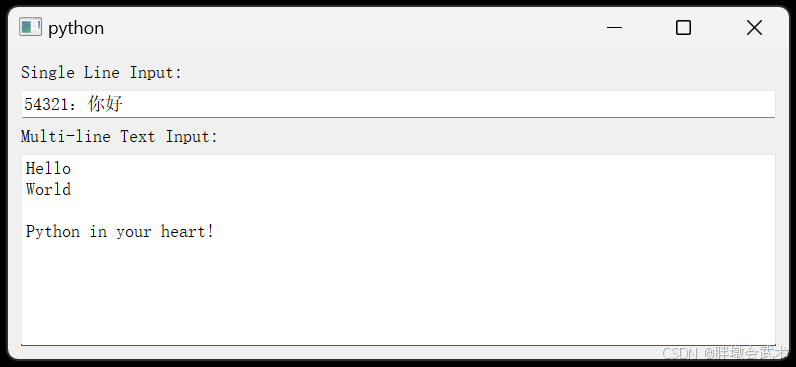
import sys
from PyQt5.QtWidgets import QApplication, QMainWindow, QVBoxLayout, QWidget, QLabel, QLineEdit, QTextEditclass MainWindow(QMainWindow):def __init__(self):super().__init__()layout = QVBoxLayout()# QLineEdit 示例self.line_edit = QLineEdit(self)self.line_edit.setPlaceholderText("Enter a number")self.line_edit.textChanged.connect(self.show_line_edit_text)# QTextEdit 示例self.text_edit = QTextEdit(self)self.text_edit.setPlaceholderText("Enter a number")self.text_edit.textChanged.connect(self.show_text_edit_text)layout.addWidget(QLabel("Single Line Input:"))layout.addWidget(self.line_edit)layout.addWidget(QLabel("Multi-line Text Input:"))layout.addWidget(self.text_edit)central_widget = QWidget()central_widget.setLayout(layout)self.setCentralWidget(central_widget)def show_line_edit_text(self, text):print("Line Edit Text:", text)def show_text_edit_text(self):text = self.text_edit.toPlainText() # 获取 QTextEdit 的文本print("Text Edit Text:", text)if __name__ == "__main__":app = QApplication(sys.argv)window = MainWindow()window.show()sys.exit(app.exec_())(1)输入框2将根据输入框1的值,自动计算;
(2)若输入框2的值自定义,则自动计算功能不启用。

import sys
from PyQt5.QtWidgets import QApplication, QMainWindow, QLineEdit, QVBoxLayout, QWidgetclass MainWindow(QMainWindow):def __init__(self):super().__init__()self.setWindowTitle("QLineEdit 信号示例")self.line_edit_1 = QLineEdit(self)self.line_edit_2 = QLineEdit(self)self.is_programmatic_change = Falseself.line_edit_1.textChanged.connect(self.on_text_changed)self.line_edit_2.textChanged.connect(self.on_text_2_changed)layout = QVBoxLayout()layout.addWidget(self.line_edit_1)layout.addWidget(self.line_edit_2)container = QWidget()container.setLayout(layout)self.setCentralWidget(container)def on_text_changed(self, text):try:value = int(text) + 1self.is_programmatic_change = Trueself.line_edit_2.setText(str(value))self.is_programmatic_change = Falseexcept ValueError:# 如果转换失败(例如输入的不是数字),则清空第二个文本框self.line_edit_2.clear()def on_text_2_changed(self, text):if self.is_programmatic_change:self.line_edit_2.setStyleSheet("color: grey;")print(f"输入框的值变化是由程序设置的,状态为{self.is_programmatic_change}")else:self.line_edit_2.setStyleSheet("color: black;")print(f"输入框的值变化是由用户手动输入的,状态为{self.is_programmatic_change}")if __name__ == '__main__':app = QApplication(sys.argv)window = MainWindow()window.show()sys.exit(app.exec_())4.2.4、校验器 QRegExpValidator :用于限制用户在 QLineEdit 中输入的文本(英文 / 数字)

import sys
from PyQt5.QtWidgets import QApplication, QMainWindow, QVBoxLayout, QWidget, QLineEdit
from PyQt5.QtCore import QRegExp
from PyQt5.QtGui import QRegExpValidatorclass MainWindow(QMainWindow):def __init__(self):super().__init__()layout = QVBoxLayout()self.line_edit = QLineEdit(self)self.line_edit.setPlaceholderText("Enter English and numbers only")# english_only = QRegExp("[a-zA-Z]+") # 创建一个正则表达式,用于匹配只包含英文字符的文本# numbers_only = QRegExp("[0-9]+") # 创建一个正则表达式,用于匹配只包含数字的文本regex = QRegExp("[A-Za-z0-9]+") # 创建一个正则表达式,只允许输入英文和数字validator = QRegExpValidator(regex)self.line_edit.setValidator(validator)layout.addWidget(self.line_edit)central_widget = QWidget()central_widget.setLayout(layout)self.setCentralWidget(central_widget)if __name__ == "__main__":app = QApplication(sys.argv)window = MainWindow()window.show()sys.exit(app.exec_())"""##########################################################################
函数功能:QRegExp 类是 Qt 中用于处理正则表达式的类。
函数说明:QRegExp(pattern: str, caseSensitivity: Qt.CaseSensitivity = Qt.CaseSensitive, syntax: QRegExp.PatternSyntax = QRegExp.RegExp)
输入参数:pattern 构造一个 QRegExp 对象,使用给定的正则表达式 pattern。caseSensitivity 指定是否区分大小写,默认为区分大小写。syntax 指定正则表达式的语法,默认为正则表达式语法。
""""""
函数功能:QRegExpValidator 类是 Qt 中用于输入验证的工具之一。它允许您使用正则表达式来限制用户在 QLineEdit 等控件中输入的文本。
函数说明:QRegExpValidator(regexp: QRegExp, parent: QObject = None)
输入参数:regexp 构造一个 QRegExpValidator 对象,使用给定的正则表达式 regexp 进行验证。parent 用于设置对象的父级。
##########################################################################"""4.2.5、校验器 QIntValidator + QDoubleValidator(整数 + 浮点数):用于限制用户在 QLineEdit 中输入的文本必须为数字。

import sys
from PyQt5.QtWidgets import QApplication, QMainWindow, QVBoxLayout, QHBoxLayout, QWidget, QLabel, QLineEdit
from PyQt5.QtGui import QIntValidator, QDoubleValidatorclass MainWindow(QMainWindow):def __init__(self):super().__init__()int_label = QLabel("Enter an int between [0, 100]:")int_label.setFixedWidth(350) # 设置固定的宽度int_validator = QIntValidator(0, 100) # 创建QIntValidator,设置范围:[0, 100]int_lineedit = QLineEdit() # 创建一个 QLineEdit 控件int_lineedit.setValidator(int_validator) # 设置校验器# 将校验器应用到QLineEdit控件中,用于限制用户只能输入 0 到 100 之间的整数。double_label = QLabel("Enter an double between [0.0, 100.0]:")double_label.setFixedWidth(350) # 设置固定的宽度double_validator = QDoubleValidator(0.0, 100.0, 2) # 创建QDoubleValidator,设置范围:[0.0, 100.0],保留两位小数double_lineedit = QLineEdit() # 创建一个 QLineEdit 控件double_lineedit.setValidator(double_validator) # 设置校验器# 将校验器应用到QDoubleValidator控件中,用于限制用户只能输入 0.0 到 100.0 之间的浮点数。# 布局管理器V_layout = QVBoxLayout()H1_layout = QHBoxLayout()H2_layout = QHBoxLayout()H1_layout.addWidget(int_label)H1_layout.addWidget(int_lineedit)H2_layout.addWidget(double_label)H2_layout.addWidget(double_lineedit)V_layout.addLayout(H1_layout)V_layout.addLayout(H2_layout)# 将布局应用于主窗口的中心区域central_widget = QWidget()central_widget.setLayout(V_layout)self.setCentralWidget(central_widget)if __name__ == "__main__":app = QApplication(sys.argv)window = MainWindow()window.show()sys.exit(app.exec_())"""##########################################################################
from PyQt5.QtGui import QIntValidator函数简介:在输入框中,限制用户输入的内容必须是符合一定范围的整数。
函数说明:QIntValidator(bottom, top, parent=None)
输入参数:bottom: 校验的最小值。top: 校验的最大值。parent: 可选,父对象。属性: bottom(): 获取校验的最小值。top(): 获取校验的最大值。
方法: setBottom(bottom): 设置校验的最小值。setTop(top): 设置校验的最大值。
##########################################################################""""""##########################################################################
from PyQt5.QtGui import QDoubleValidator函数简介:在输入框中,限制用户输入的内容必须是符合一定范围的整数。
函数说明:QDoubleValidator(bottom, top, decimals, parent=None)
输入参数:bottom: 浮点数的最小值,用户输入的浮点数不能小于该值。top: 浮点数的最大值,用户输入的浮点数不能大于该值。decimals: 小数位数,表示允许的小数点后的位数。parent: 可选参数,父级 QObject。方法: bottom(): 返回校验器设置的最小值。top(): 返回校验器设置的最大值。decimals(): 返回校验器设置的小数位数。setBottom(bottom: float): 设置校验器的最小值。setTop(top: float): 设置校验器的最大值。setDecimals(decimals: int): 设置校验器的小数位数。
##########################################################################"""4.2.6、输入框 QSpinBox + QDoubleSpinBox(整数 + 浮点数):支持上下按钮调节

import sys
from PyQt5.QtWidgets import QApplication, QMainWindow, QVBoxLayout, QHBoxLayout, QWidget, QSpinBox, QDoubleSpinBox, QLabelclass MainWindow(QMainWindow):def __init__(self):super().__init__()# 使用 QSpinBox 限制整数范围QSpinBox_label = QLabel("int input:")int_spinbox = QSpinBox()int_spinbox.setRange(0, 100) # 限制范围:[0, 100]# 使用 QDoubleSpinBox 限制浮点数范围QDoubleSpinBox_label = QLabel("double input:")double_spinbox = QDoubleSpinBox()double_spinbox.setRange(0.0, 100.0) # 限制范围:[0.0, 100.0]double_spinbox.setDecimals(2) # 保留2位小数# 布局管理器V_layout = QVBoxLayout() # 垂直布局H1_layout = QHBoxLayout() # 水平布局H2_layout = QHBoxLayout() # 水平布局H1_layout.addWidget(QSpinBox_label)H1_layout.addWidget(int_spinbox)V_layout.addLayout(H1_layout)H2_layout.addWidget(QDoubleSpinBox_label)H2_layout.addWidget(double_spinbox)V_layout.addLayout(H2_layout)# 将布局应用于主窗口的中心区域central_widget = QWidget()central_widget.setLayout(V_layout)self.setCentralWidget(central_widget)if __name__ == "__main__":app = QApplication(sys.argv)window = MainWindow()window.show()sys.exit(app.exec_())4.2.7、滑动条 QSlider:获取滑动条点击前后的值

from PyQt5.QtWidgets import QApplication, QMainWindow, QVBoxLayout, QWidget, QSlider, QLabel
from PyQt5.QtCore import Qtclass MainWindow(QMainWindow):def __init__(self):super().__init__()layout = QVBoxLayout()self.slider = QSlider()self.slider.setOrientation(Qt.Horizontal)self.slider.setRange(0, 100)layout.addWidget(self.slider)self.label = QLabel("Previous Value: 0, Current Value: 0")layout.addWidget(self.label)self.previous_value = 0self.slider.valueChanged.connect(self.slider_value_changed)central_widget = QWidget()central_widget.setLayout(layout)self.setCentralWidget(central_widget)def slider_value_changed(self, new_value):self.label.setText(f"Previous Value: {self.previous_value}, Current Value: {new_value}")self.previous_value = self.slider.value() # self.slider.value():获取的是点击slider之后的值,而不是当前slider显示的值if __name__ == "__main__":app = QApplication([])window = MainWindow()window.show()app.exec_()4.2.8、进度条 QProgressBar:创建一个进度条窗口(0~100%)
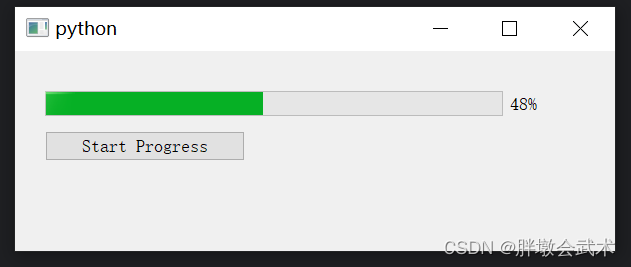
import sys
from PyQt5.QtWidgets import QApplication, QMainWindow, QPushButton, QProgressBar
from PyQt5.QtCore import QTimerclass MainWindow(QMainWindow):def __init__(self):super().__init__()# 设置窗口的几何属性self.setGeometry(100, 100, 600, 200)# 创建一个进度条并设置其几何属性self.progress_bar = QProgressBar(self)self.progress_bar.setGeometry(30, 40, 500, 25)# 创建一个 "Start Progress" 按钮start_button = QPushButton('Start Progress', self)# 连接按钮的点击事件到 startProgress 函数start_button.clicked.connect(self.startProgress)# 设置按钮的固定宽度和位置start_button.setFixedWidth(200)start_button.move(30, 80)def startProgress(self):# 初始化进度为0self.progress = 0# 创建一个定时器self.timer = QTimer(self)# 连接定时器的超时事件到 updateProgress 函数self.timer.timeout.connect(self.updateProgress)# 每0.1秒触发一次定时器self.timer.start(100)def updateProgress(self):# 增加进度self.progress += 1# 设置进度条的值self.progress_bar.setValue(self.progress)# 当进度达到100%时,停止定时器if self.progress >= 100:self.timer.stop()if __name__ == '__main__':app = QApplication(sys.argv)window = MainWindow()window.show()sys.exit(app.exec_())4.2.9、下拉框 QComboBox:创建一个下拉框并添加选项

import sys
from PyQt5.QtWidgets import QApplication, QMainWindow, QVBoxLayout, QWidget, QLabel, QComboBoxclass MainWindow(QMainWindow):def __init__(self):super().__init__()label = QLabel("Select an option:")combo_box = QComboBox()combo_box.addItem("Option 1")combo_box.addItem("Option 2")combo_box.addItem("Option 3")combo_box.currentIndexChanged.connect(self.selection_changed) # 连接选项变更事件self.result_label = QLabel("", self)layout = QVBoxLayout()layout.addWidget(combo_box)layout.addWidget(label)layout.addWidget(self.result_label)central_widget = QWidget()central_widget.setLayout(layout)self.setCentralWidget(central_widget)def selection_changed(self, index):selected_option = self.sender().currentText()self.result_label.setText(f"Selected: {selected_option}")if __name__ == "__main__":app = QApplication(sys.argv)window = MainWindow()window.show()sys.exit(app.exec_())4.2.10、复选框 QCheckBox:获取勾选状态

import sys
from PyQt5.QtWidgets import QApplication, QLabel, QCheckBox, QVBoxLayout, QWidgetclass CheckBoxExample(QWidget):def __init__(self):super().__init__()self.initUI()def initUI(self):self.setWindowTitle('QCheckBox')self.label = QLabel("")self.checkBox = QCheckBox("Option")layout = QVBoxLayout()layout.addWidget(self.checkBox)layout.addWidget(self.label)self.setLayout(layout)self.checkBox.clicked.connect(self.on_checkbox_clicked)def on_checkbox_clicked(self):if self.checkBox.isChecked():self.label.setText("checkBox is checked")else:self.label.setText("checkBox is unchecked")if __name__ == '__main__':app = QApplication(sys.argv)window = CheckBoxExample()window.show()sys.exit(app.exec_())4.2.11、单选按钮 QRadioButton:获取勾选状态

import sys
from PyQt5.QtWidgets import QApplication, QLabel, QRadioButton, QVBoxLayout, QWidgetclass RadioButtonExample(QWidget):def __init__(self):super().__init__()self.initUI()def initUI(self):self.setWindowTitle('QRadioButton')# 创建标签self.label = QLabel("")# 创建单选按钮self.radioButton1 = QRadioButton("Option 1")self.radioButton2 = QRadioButton("Option 2")self.radioButton3 = QRadioButton("Option 3")# 将单选按钮和标签添加到布局layout = QVBoxLayout()layout.addWidget(self.radioButton1)layout.addWidget(self.radioButton2)layout.addWidget(self.radioButton3)layout.addWidget(self.label)# 将布局设置为窗口的主布局self.setLayout(layout)# 连接单选按钮的点击事件到槽函数self.radioButton1.clicked.connect(self.on_radio_button_clicked)self.radioButton2.clicked.connect(self.on_radio_button_clicked)self.radioButton3.clicked.connect(self.on_radio_button_clicked)def on_radio_button_clicked(self):sender = self.sender() # 获取点击的单选按钮self.label.setText("You selected: " + sender.text()) # 更新标签文本if __name__ == '__main__':app = QApplication(sys.argv)window = RadioButtonExample()window.show()sys.exit(app.exec_())4.2.12、分组框 QGroupBox:将其他小部件放置在其中

from PyQt5.QtWidgets import QApplication, QGroupBox, QHBoxLayout, QRadioButton, QVBoxLayout, QWidgetapp = QApplication([])widget = QWidget()# 创建布局
main_layout = QVBoxLayout()
group_box = QGroupBox("Options")
group_box_layout = QVBoxLayout()# 创建组件
button1 = QRadioButton("Option 1")
button2 = QRadioButton("Option 2")
button3 = QRadioButton("Option 3")
button4 = QRadioButton("Option 4")# 将组件添加到布局
layout1 = QHBoxLayout()
layout1.addWidget(button1)
layout1.addWidget(button2)layout2 = QHBoxLayout()
layout2.addWidget(button3)
layout2.addWidget(button4)group_box_layout.addLayout(layout1)
group_box_layout.addLayout(layout2)
group_box.setLayout(group_box_layout)# 添加组件到主布局
main_layout.addWidget(group_box)
widget.setLayout(main_layout)
widget.show()app.exec_()4.2.12、打印日志 QTextEdit:获取当前时间 + 设置文本颜色
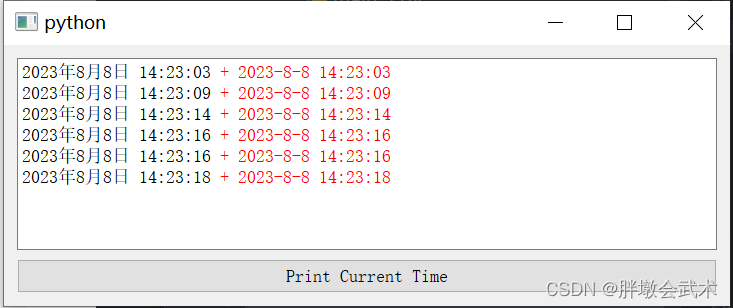
from PyQt5.QtWidgets import QApplication, QTextEdit, QVBoxLayout, QPushButton, QMainWindow, QWidget
from PyQt5.QtCore import Qt, QDateTimeclass MainWindow(QMainWindow):def __init__(self):super().__init__()self.log_text_edit = QTextEdit()self.button = QPushButton("Print Current Time")self.button.clicked.connect(self.print_current_time)layout = QVBoxLayout()layout.addWidget(self.log_text_edit)layout.addWidget(self.button)widget = QWidget()widget.setLayout(layout)self.setCentralWidget(widget)def print_current_time(self):current_time1 = QDateTime.currentDateTime().toString(Qt.DefaultLocaleLongDate) # 指定默认格式current_time2 = QDateTime.currentDateTime().toString("yyyy-M-d hh:mm:ss") # 指定日期格式message = current_time1 + r'<font color="red"> + {}</font>'.format(current_time2)self.log_text_edit.append(message)if __name__ == '__main__':app = QApplication([])window = MainWindow()window.show()app.exec()from datetime import datetimecurrent_time = datetime.now() # 获取当前时间
formatted_time = current_time.strftime("%Y-%m-%d %H:%M:%S")
print("Time:", formatted_time) # 打印格式化后的时间
# Time: 2023-08-08 14:25:29
4.2.13、消息提示框 QMessageBox:信息 / 询问 / 警告 / 错误
import sys
from PyQt5.QtWidgets import QApplication, QMainWindow, QPushButton, QVBoxLayout, QWidget, QMessageBoxclass MainWindow(QMainWindow):def __init__(self):super().__init__()info_button = QPushButton("Information")question_button = QPushButton("Question")warning_button = QPushButton("Warning")critical_button = QPushButton("Critical")info_button.clicked.connect(self.show_information)question_button.clicked.connect(self.show_question)warning_button.clicked.connect(self.show_warning)critical_button.clicked.connect(self.show_critical)layout = QVBoxLayout()layout.addWidget(info_button)layout.addWidget(question_button)layout.addWidget(warning_button)layout.addWidget(critical_button)widget = QWidget()widget.setLayout(layout)self.setCentralWidget(widget)def show_information(self):QMessageBox.information(self, "Information", "This is an information message.", QMessageBox.Ok, QMessageBox.Ok)def show_question(self):result = QMessageBox.question(self, "Question", "Do you want to proceed?", QMessageBox.Yes | QMessageBox.No, QMessageBox.No)if result == QMessageBox.Yes:print("User clicked Yes")else:print("User clicked No")def show_warning(self):QMessageBox.warning(self, "Warning", "This is a warning message.", QMessageBox.Ok, QMessageBox.Ok)def show_critical(self):QMessageBox.critical(self, "Critical", "This is a critical message.", QMessageBox.Ok, QMessageBox.Ok)if __name__ == "__main__":app = QApplication(sys.argv)window = MainWindow()window.show()sys.exit(app.exec_())"""##########################################################################
from PyQt5.QtWidgets import QMessageBox函数简介:用于显示消息框、询问框、警告框等用户交互提示框的类。
函数说明:信息消息框 QMessageBox.information(parent, title, message, buttons, defaultButton)询问消息框 QMessageBox.question(parent, title, message, buttons, defaultButton)警告消息框 QMessageBox.warning(parent, title, message, buttons, defaultButton)严重错误消息框 QMessageBox.critical(parent, title, message, buttons, defaultButton)
输入参数:parent: 可选参数,父级窗口。title: 消息框的标题。message: 消息框中显示的消息文本。buttons: 消息框中显示的按钮类型,如 QMessageBox.Yes、QMessageBox.No 等。defaultButton: 可选参数,指定默认按钮。
##########################################################################"""
def show_warning(message=None):import tkinter as tkfrom tkinter import messageboxroot = tk.Tk()root.withdraw() # 隐藏主窗口messagebox.showwarning("Warning", message)root.destroy() # 关闭主窗口if __name__ == '__main__':show_warning(message="请仔细检查")4.2.14、选项卡界面 QTabWidget
4.2.14.1、在一个窗口中显示多个页面
Tab控件:可以在一个窗口中显示多个页面,每个页面对应一个选项卡,用户可以通过点击选项卡来切换不同的页面。
from PyQt5.QtWidgets import QApplication, QMainWindow, QTabWidget, QWidget, QVBoxLayout, QLabelclass MyWindow(QMainWindow):def __init__(self):super().__init__()# 创建Tab控件self.tab_widget = QTabWidget()self.setCentralWidget(self.tab_widget)# 创建页面并添加到Tab控件中self.page1 = QWidget()self.page2 = QWidget()self.tab_widget.addTab(self.page1, "Page 1")self.tab_widget.addTab(self.page2, "Page 2")# 设置页面的布局和内容layout1 = QVBoxLayout()layout1.addWidget(QLabel("This is Page 1"))self.page1.setLayout(layout1)layout2 = QVBoxLayout()layout2.addWidget(QLabel("This is Page 2"))self.page2.setLayout(layout2)if __name__ == "__main__":app = QApplication([])window = MyWindow()window.show()app.exec_()4.2.14.2、在主界面中,显示其他.py界面类文件
实现选项卡自动显示不同界面,可以在主界面的初始化过程中创建并添加不同的界面类实例,并根据选项卡的切换来显示相应的界面。
# main.pyimport sys
from PyQt5.QtWidgets import QApplication, QMainWindow, QTabWidget, QVBoxLayout, QWidget, QPushButton
from other_file import OtherWindow # 导入其他文件中的界面类class MainWindow(QMainWindow):def __init__(self):super().__init__()self.setWindowTitle("Main Window")self.setGeometry(200, 200, 300, 200)# 创建一个QTabWidget控件self.tab_widget = QTabWidget(self)self.setCentralWidget(self.tab_widget)# 创建页面1和页面2self.page1 = QWidget()self.page2 = OtherWindow() # 调用其他文件中的界面类# 将页面1和页面2添加到QTabWidget控件中self.tab_widget.addTab(self.page1, "Page 1")self.tab_widget.addTab(self.page2, "Page 2")if __name__ == "__main__":app = QApplication(sys.argv)main_window = MainWindow()main_window.show()sys.exit(app.exec_())# other_file.pyimport sys
from PyQt5.QtWidgets import QApplication, QWidget, QLabel, QVBoxLayout, QHBoxLayout, QPushButton, QFileDialogclass OtherWindow(QWidget):def __init__(self):super().__init__()self.button = QPushButton("load:", self)self.button.clicked.connect(self.load_image)self.label = QLabel("")button_layout = QHBoxLayout()button_layout.addWidget(self.button)button_layout.addWidget(self.label)layout = QVBoxLayout()layout.addLayout(button_layout) # 将button_layout布局添加到主布局中self.setLayout(layout) # 设置窗口的主布局def load_image(self):self.folder_path = QFileDialog.getExistingDirectory(self, 'Select Folder', './')if self.folder_path:print('Selected Folder:', self.folder_path)self.label.setText(self.folder_path)if __name__ == '__main__':app = QApplication(sys.argv)window = OtherWindow()window.show()sys.exit(app.exec_())4.2.14.3、在主界面中,显示其他.py界面类文件,并进行数据交互
# main.pyimport sys
from PyQt5.QtWidgets import QApplication, QMainWindow, QTabWidget, QVBoxLayout, QWidget, QLineEdit, QPushButton, QHBoxLayout
from other_file import OtherWindowclass MainWindow(QMainWindow):def __init__(self):super().__init__()self.setWindowTitle("Main Window")self.setGeometry(200, 200, 300, 200)self.send_button = QPushButton("Send Parameter", self) # 新建按钮,并设置初始参数self.send_button.clicked.connect(self.send_parameter) # 使用connect方法将信号连接到槽self.send_button.setStyleSheet("background-color: black; color: white;") # 设置按钮的背景和字体颜色self.input_line_edit = QLineEdit("Enter Parameter", self) # 新建文本框,并设置初始参数###################################################################### 创建一个QTabWidget控件self.tab_widget = QTabWidget(self)self.setCentralWidget(self.tab_widget)# 创建页面1和页面2self.page1 = QWidget()self.other_window = OtherWindow() # 调用其他文件中的界面类# 将页面1和页面2添加到QTabWidget控件中self.tab_widget.addTab(self.page1, "Page 1")self.tab_widget.addTab(self.other_window, "Page 2")#####################################################################self.button_layout = QHBoxLayout()self.button_layout.addWidget(self.send_button)self.button_layout.addWidget(self.input_line_edit)layout = QVBoxLayout()layout.addLayout(self.button_layout)layout.addWidget(self.tab_widget)central_widget = QWidget()central_widget.setLayout(layout)self.setCentralWidget(central_widget)def send_parameter(self):parameter = self.input_line_edit.text()self.other_window.receive_parameter(parameter) # 调用其他界面类other_window中的函数receive_parameterif __name__ == "__main__":app = QApplication(sys.argv)window = MainWindow()window.show()sys.exit(app.exec_())# other_file.pyfrom PyQt5.QtWidgets import QApplication, QWidget, QVBoxLayout, QHBoxLayout, QPushButton, QLabel
import sysclass OtherWindow(QWidget):def __init__(self):super().__init__()button_layout = QHBoxLayout() # 水平布局管理器self.Received_button = QPushButton("Received Parameter", self) # 新建按钮,并设置初始参数self.Received_button.setStyleSheet("background-color: black; color: white;") # 设置按钮的背景和字体颜色self.label = QLabel("Hello from Other Window!")button_layout.addWidget(self.Received_button)button_layout.addWidget(self.label)layout = QVBoxLayout()layout.addLayout(button_layout)self.setLayout(layout)def receive_parameter(self, parameter):self.label.setText(f"{parameter}")if __name__ == "__main__":app = QApplication(sys.argv)window = OtherWindow()window.show()sys.exit(app.exec_())4.2.15、调用其他.py文件,并数据交互
共有两种方法:
- (1)
QProcess(process.start):需要依赖Qt库。实现与外部应用程序的交互、启动和管理等功能,更加灵活。适用于更复杂的交互和进程管理。- (2)
subprocess(subprocess.run):Python标准库提供的方法,更加简单方便。适用于在Python脚本中执行外部命令或脚本,并获取其结果。
测试文件.py
# other_file.py# 在这里进行运算或其他处理
result = 42
# 将结果打印到控制台
print(result)
print("result =", result + 1)
print("result" + " + " + "result")方法一:subprocess(subprocess.run)
# main.pyimport sys
import subprocessfrom PyQt5.QtWidgets import QApplication, QMainWindow, QVBoxLayout, QWidget, QPushButton, QLabelclass MainWindow(QMainWindow):def __init__(self):super().__init__()self.run_button = QPushButton("run .py")self.run_button.clicked.connect(self.run)self.run_label = QLabel("", self)layout = QVBoxLayout()layout.addWidget(self.run_button)layout.addWidget(self.run_label)central_widget = QWidget()central_widget.setLayout(layout)self.setCentralWidget(central_widget)def run(self):try:########################################################## 若不确定other_file.py是否调用成功,可以使用绝对路径。# 不建议:调用.py文件# 建议:将py文件封装成一个函数,然后调用函数。#########################################################result = subprocess.run(["python", "other_file.py"], capture_output=True, text=True, check=True)output = result.stdout.strip() # 获取输出结果并去除首尾空格self.run_label.setText(output)except subprocess.CalledProcessError as e:self.run_label.setText(str(e))if __name__ == "__main__":app = QApplication(sys.argv)window = MainWindow()window.show()sys.exit(app.exec_())"""##########################################################################
import subprocess函数简介:Python标准库subprocess模块中的一个函数,用于运行一个子进程并等待其完成。可以执行系统命令或其他可执行文件,并可以通过参数来控制进程的行为和交互。
函数说明:subprocess.run(args, *, stdin=None, input=None, stdout=None, stderr=None, shell=False, cwd=None, timeout=None, check=False, encoding=None, errors=None, text=None, env=None, universal_newlines=None, start_new_session=False)
输入参数:args: 要运行的命令或可执行文件,以列表或字符串形式传递。如果shell=True,可以传递一个字符串,使用Shell运行命令。stdin: 用于传递子进程的标准输入的文件对象。input: 用于传递子进程的标准输入的字节或字符串数据。stdout: 用于接收子进程的标准输出的文件对象。stderr: 用于接收子进程的标准错误输出的文件对象。shell: 是否在Shell中运行命令。如果为True,可以使用通配符等Shell特性。cwd: 子进程的当前工作目录。timeout: 等待子进程完成的超时时间,如果子进程在此时间内未完成,将会被终止。check: 是否检查返回代码。如果为True,如果子进程返回的代码非零,将会引发CalledProcessError异常。encoding: 用于解码子进程输出的编码。errors: 用于处理解码错误的策略。text: 是否使用文本模式传递数据,相当于同时设置universal_newlines和encoding。env: 用于指定子进程的环境变量。universal_newlines: 是否使用通用换行符模式,相当于同时设置stdin、stdout和stderr的text参数。start_new_session: 是否在新的会话(session)中启动子进程。
输出参数:返回一个CompletedProcess对象,它包含有关子进程执行的信息,如返回代码、标准输出、标准错误等。
##########################################################################"""
方法二:QProcess(process.start)
# main.pyimport sys
from PyQt5.QtWidgets import QApplication, QMainWindow, QVBoxLayout, QWidget, QPushButton, QLabel
from PyQt5.QtCore import QProcessclass MainWindow(QMainWindow):def __init__(self):super().__init__()self.run_button = QPushButton("run .py")self.run_button.clicked.connect(self.run)self.run_label = QLabel("", self)layout = QVBoxLayout()layout.addWidget(self.run_button)layout.addWidget(self.run_label)central_widget = QWidget()central_widget.setLayout(layout)self.setCentralWidget(central_widget)def run(self):# 清空结果标签self.run_label.setText("")########################################################## (1)启动进程执行外部脚本process = QProcess()python_script = r'other_file.py' # 注意:若不确定other_file.py是否调用成功,可以使用绝对路径。para1 = str(9) # (1)传递参数只能是字符串(2)与外部脚本完成交互。process.start("python", [python_script, para1])process.waitForFinished(-1) # 用于等待进程执行完成。传入参数-1表示无限等待# (2)进程的退出代码:(1)0表示进程成功执行完成;(2)非零值表示出现错误。exit_code = process.exitCode()if exit_code == 0:self.run_label.setText("调用【成功】,退出代码:{}".format(exit_code))else:self.run_label.setText("调用【失败】,退出代码:{}".format(exit_code))if __name__ == "__main__":app = QApplication(sys.argv)window = MainWindow()window.show()sys.exit(app.exec_())"""######################################################################################
# 函数介绍:QProcess 是 Qt 框架中用于创建和管理外部进程的类。它允许你启动外部应用程序,并与其进行通信。
# 常见方法:
# (1)启动外部进程: 使用start()方法启动一个外部进程
# (2)与进程通信: 使用write()方法向进程的标准输入写入数据,并使用readAllStandardOutput()和readAllStandardError()方法读取进程的标准输出和标准错误输出。
# (2)等待进程执行完成: 使用waitForFinished()方法来等待进程执行完成
# (3)获取进程退出代码: 使用exitCode()方法可以获取进程的退出代码
# (4)支持信号与槽机制: 使用readyReadStandardOutput()信号在进程有标准输出可读时发出
# (5)中断进程: 使用terminate()方法尝试终止进程的执行。不一定会立即停止进程,具体行为取决于操作系统和进程本身。
#
# process = QProcess()
# process.start("python", ["script.py", "arg1", "arg2"])
# if process.waitForFinished():
# print("Process finished")
# exit_code = process.exitCode()
# if exit_code == 0:
# print("调用成功")
# else:
# print("调用失败,退出代码:", exit_code)
#
# process.write(b"input data")
# output = process.readAllStandardOutput()
# error_output = process.readAllStandardError()
# process.readyReadStandardOutput.connect(handle_output)
# process.terminate()
######################################################################################""""""######################################################################################
# 函数介绍:waitForFinished 是 QProcess 类的一个成员函数。用于阻塞当前线程,直到关联的进程完成执行为止。
# 函数说明:bool QProcess.waitForFinished(int msecs = 30000)
# 输入参数: msecs:等待的时间(以毫秒为单位)。默认值是 30000 毫秒(30 秒)。如果设置为 -1,表示无限等待。
# 输出参数: 如果进程在给定的时间内完成执行,则返回 True,否则返回 False。
#
# (1)主要用于等待 QProcess 执行外部程序的过程完成。程序会阻塞当前线程,阻塞在当前行,直到被调用的进程执行完毕。
# (2)如果进程执行的时间很长,这会导致界面冻结,因为界面线程会被阻塞。
# (3)如果你需要在界面上显示进度或状态,或者想要允许用户继续操作界面,而不阻塞界面线程,可以考虑使用多线程、异步编程等技术,以避免界面的冻结。
######################################################################################"""4.2.16、在当前虚拟环境下,调用其他虚拟环境下的.py文件,并数据交互
import subprocess
import osvirtual_env_name = "tensorflow36" # (1)指定要激活的虚拟环境名称
cmd_activate_env = f"conda activate {virtual_env_name}" # (2)构建激活虚拟环境的命令script_path = r"deeplearning.py" # (3)指定.py文件路径
path = os.getcwd() + 'image.tif' # (4)指定.py文件参数
cmd_script_file = f"python {script_path} --image_path {path}" # (5)构建调用.py文件的命令,包括传递参数# (6)使用subprocess执行命令
###################################################################################
# 在Windows上,通过subprocess.run来激活一个Conda环境并不是一种有效的方式。
# 原因分析:因为conda activate命令会在一个新的子进程中执行,该子进程的环境变量变化不会影响到当前Python进程中运行的后续代码。
# 解决方法:将激活环境和执行py文件的命令,同时传递给subprocess.run。
###################################################################################
combined_cmd = f"{cmd_activate_env} && {cmd_script_file}" # 组合两个命令并在子进程中执行
try:subprocess.run(combined_cmd, shell=True, check=True)
except subprocess.CalledProcessError as e:print(f"Error: {e}")"""######################################################################
import argparse # 导入argparse模块if __name__ == "__main__":parser = argparse.ArgumentParser() # 创建解析对象parser.add_argument('--image_path') # 添加命令行参数和选项args = parser.parse_args() # 解析添加的参数image_path = args.image_path # 获取添加的参数
######################################################################"""







